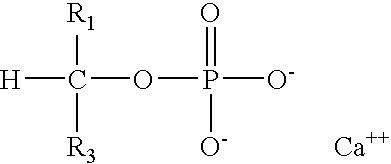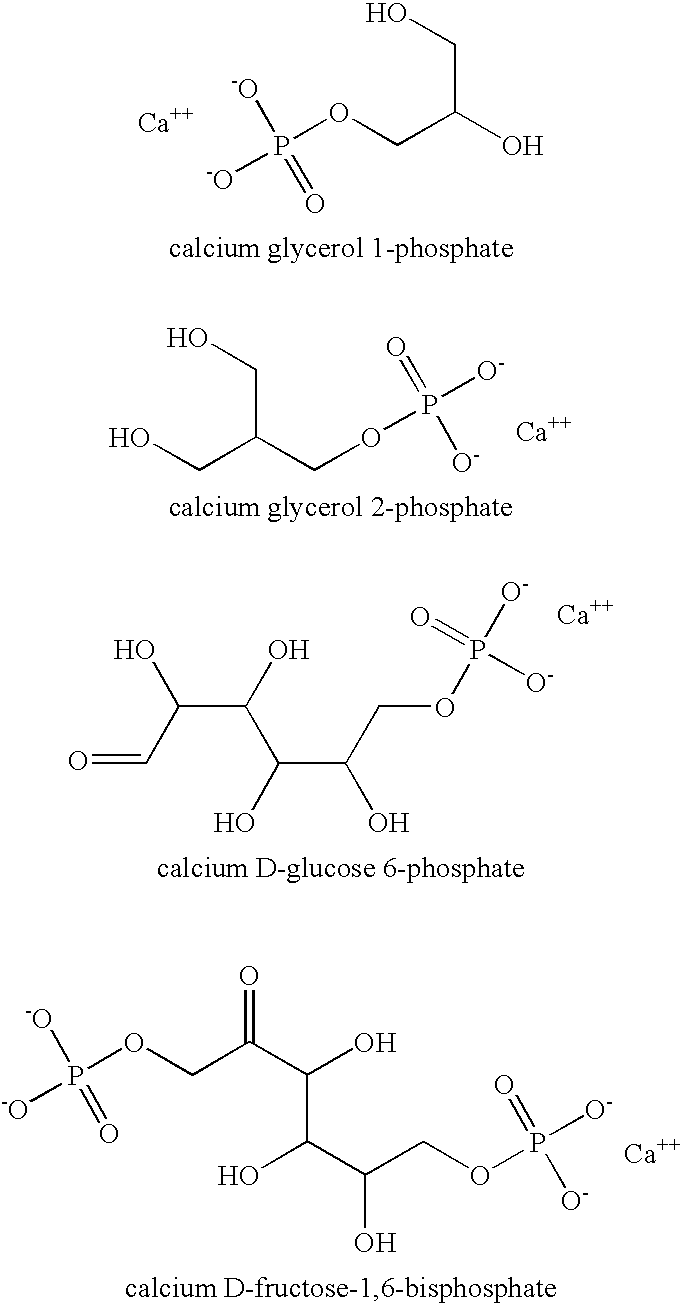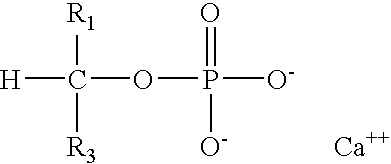Hygiene Article Having Calcium Sugar Phosphate
a technology of hygiene articles and calcium sugar phosphate, which is applied in the directions of phosphorous compound active ingredients, biocide, antibacterial agents, etc., can solve the problems of difficult to eradicate i>s. aureus /i>bacteria without harming members, and the use of antibiotics that kill i>s. aureus /i>is not viable for feminine articles
- Summary
- Abstract
- Description
- Claims
- Application Information
AI Technical Summary
Problems solved by technology
Method used
Image
Examples
example 1
[0048]This example demonstrates the reduction of the amount of TSST-1, as measured by the Enzyme-Linked ImmunoSorbent Assay (ELISA), produced by S. aureus grown using the shake flask assay, upon the addition of low concentrations, less than about 5 mM Ca, of calcium sugar phosphates of the present invention.
[0049]Materials and Methods
[0050]Shake Flask Method
[0051]The Shake Flask Method was performed in triplicate with appropriate controls. Twenty-five mL of Brain Heart Infusion broth (BHI) (Difco-BD Biosciences, Bedford, Mass.) was dispensed into 250 mL flasks and the flasks were covered. The medium was autoclaved at 121°-124° C. for 15 minutes and allowed to cool to room temperature.
[0052]A calcium sugar phosphate solution was prepared by dissolving an appropriate amount of calcium sugar phosphate into 2.5 mM Phosphate Buffered Saline (PBS) / 150 mM sodium chloride, pH 7.0. The calcium sugar phosphate solution was added to the BHI medium supplemented with 1% yeast extract at a volume...
example 2
[0065]This example demonstrates the ability of calcium sugar phosphates to almost completely disrupt production at higher concentrations. In addition, the example demonstrates that at higher concentrations calcium sugar phosphates are more effective at reducing TSST-1 production than calcium salts.
[0066]Materials and Methods
[0067]The materials and methods used (Shake Flask Method and ELISA) were the same as those used for EXAMPLE 1.
TABLE 2% TSST-1Ca (mM)Change% TSST-1 ChangeSolubility (mMadded to(μg / ml) vs.(μg / ml / mM) vs.of Calcium inCompoundshake flaskcontrolcontrolH2O at 25° C.)Comparative Examples (Calcium Salts)calcium chloride75.6821.17324calcium stearate*98.8620.6calcium lactate53.1891.7229calcium citrate22.6883.945.1malatecalcium36.0982.795.2glycerophosphate*calcium stearate solid is added directly into the media
[0068]This example demonstrates that calcium sugar phosphates, in this instance calcium glycerophosphate: (1) at higher concentrations of about 36.0 mM Ca (as compared...
example 3
[0069]This example demonstrates that calcium sugar phosphates are more effective at reducing TSST-1 production by S. aureus than sodium sugar phosphates.
[0070]Materials and Methods
[0071]The materials and methods used (Shake Flask Method and ELISA) were the same as those used for EXAMPLE 1.
TABLE 3Anion (mM) added% TSST-1 ChangeCompoundto shake flask(μg / ml) vs. controlsodium glycerophosphate38.931% reductioncalcium glycerophosphate36.098% reduction
[0072]This example demonstrates that calcium sugar phosphates, in this instance calcium glycerophosphate, are more effective at reducing TSST-1 production than sodium sugar phosphates, in this instance sodium glycerophosphate, as demonstrated in Table 3, wherein calcium glycerophosphate at a concentration of 36.0 mM reduced TSST-1 production by 98%, as compared to sodium glycerophosphate at a concentration of 38.9 mM which reduced TSST-1 production by only 3 1%.
PUM
| Property | Measurement | Unit |
|---|---|---|
| temperatures | aaaaa | aaaaa |
| temperature | aaaaa | aaaaa |
| temperature | aaaaa | aaaaa |
Abstract
Description
Claims
Application Information
 Login to View More
Login to View More - R&D
- Intellectual Property
- Life Sciences
- Materials
- Tech Scout
- Unparalleled Data Quality
- Higher Quality Content
- 60% Fewer Hallucinations
Browse by: Latest US Patents, China's latest patents, Technical Efficacy Thesaurus, Application Domain, Technology Topic, Popular Technical Reports.
© 2025 PatSnap. All rights reserved.Legal|Privacy policy|Modern Slavery Act Transparency Statement|Sitemap|About US| Contact US: help@patsnap.com



